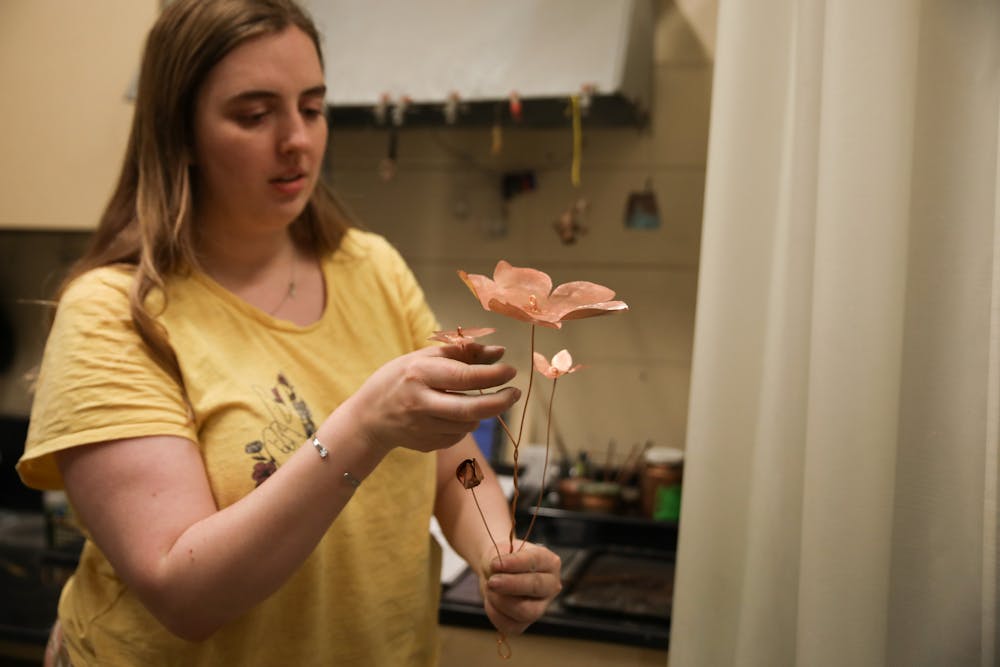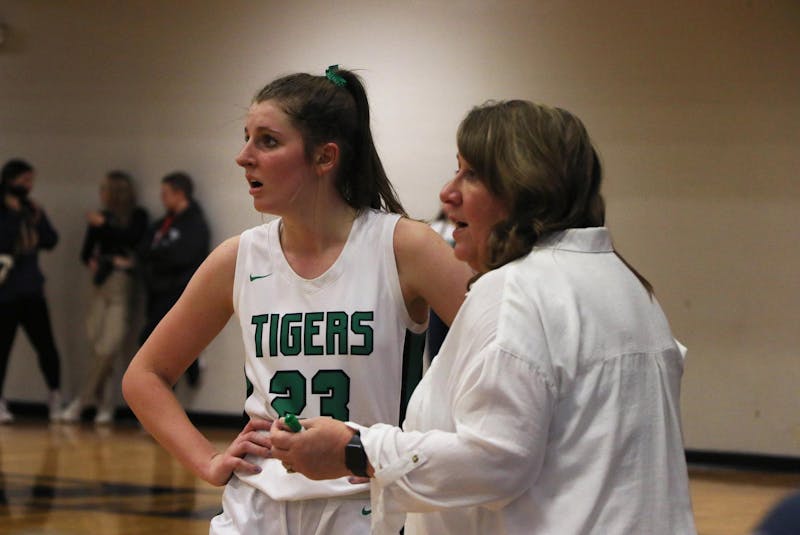It only took one class.
Kinzee Davis and Victoria Stout started in drawing. Arielle Birk started in animation, and Kelsey Bobrowski wanted to pursue the same. But after getting a taste of metals, each of the students decided a focus in metals is what they needed to go after.
“I saw metals and signed up for it not really thinking much of it, didn't really know what all it entailed, but I immediately fell in love with it …” Davis said. “Just everything about it. I felt like I was finally connecting to the material that I was working with.”
As the end of the year approaches, future graduates in the metals concentration are wrapping up their time and preparing their theses and final galleries before stepping into the world of metalsmithing.
A metalsmith is defined as an artist or craftsman who works with metal, most often used for jewelry or sculptures, according to Collins Dictionary.
The metals program at Ball State is a part of the School of Art and requires 60 credits. Through the concentration, students are able to use their hands and technology to produce their own works and pieces of art from an assortment of metals, including copper, silver and gold, as well as gemstones and other materials.
Similar to many students in the metals concentration, Ball State’s associate professor of metals and jewelry, Jessica Calderwood, didn’t originally pursue metals when she was in college either. She didn’t discover her love for the tactile art form until her boyfriend at the time recommended she take it as an elective. She switched from painting to metals, and the rest was history. Now, Calderwood has been teaching at Ball State since 2016.
As a part of the program, Calderwood decided to change the metals concentration to metals and jewelry, widening the scope. Calderwood is one in a small group of professors who teach metals at Ball State. Although she is currently on sabbatical, with Natalie Lowe, assistant teaching professor, teaching in her place, she is still just as passionate.
“The material that we work in is incredibly relevant, especially to everyone's daily life,” Calderwood said. “Everybody uses metal objects in their daily life, … many people wear jewelry, and it's such a signifier of our class, our identity, religion and just personal design preferences.”
Due to the complexity of metals, students are able to learn about other forms of art in metals as well. While Calderwood is away, she is currently working on combining glass and metal in her pieces. She is still an active artist, and she encourages her students to pursue getting real-world experience.
One way students are able to do this is through the Metals Guild, a club at Ball State for metalsmiths, though it’s open to students outside of the concentration. The guild helps students gain experience selling their work. The money raised from their sales, often in the Atrium, goes partly in the pockets of the students and also toward annual trips and expos.
Stout, the president of the Metals Guild and fourth-year metals major, has even helped bring in guest speakers. Stout said the sales are beneficial to students in preparing them for post graduation through understanding how to sell their work and get along with others.
“It was the first time that I ever was actually able to sell my art in a way that felt good. I had tried doing drawing commissions so many times, and it just was not for me,” she said. “But within this, I feel so much more capable, and I’m able to make my art, and then people are like, ‘I want it,’ and that's all I've ever wanted.”
Stout will be graduating in fall 2024, alongside Birk, vice president of the Metals Guild and sixth-year animation and metals student. The two were in a sculpture class when they made a pact to pursue metals together.

In the metals studio, Birk is often referred to as the “rabbit lady.” Due to the rabbit being her Chinese zodiac and the animal having shown up during difficult times in her life, the rabbit has become a symbol for her. She said she’s heard an animal showing up in your life this way can mean they are your “spirit animal.” She uses rabbits in most of her work, which mainly includes broaches and other wearable art.
“I put a lot of spirituality in my pieces, but not everybody agrees with you on spirituality or religion, so I try to be as broad and accommodating as possible of other people's views while also still putting my views in perspective,” she said.
The Muncie native was born for the role in metals, combining her mother’s love of fashion and her father’s role in construction management.
Birk works at HeidiJHale Designs, a jewelry shop in Muncie. She has been making rings while being mentored by the owner. After graduation, she plans to work there and gain experience, and, ultimately, she hopes to open a jewelry business of her own in Muncie.
Alongside Birk, Davis, fourth-year fine arts major with a concentration in metals, also works at HeidiJHale Designs. When she graduates this spring, she is going to start as Heidi’s “second hand person.”
Davis is a big jewelry person, having sold earrings on her Instagram and through sales with the Metals Guild. She enjoys making wearable metals, coming from a dream of being a fashion designer when she was 8.
“There probably is something in me that's just like I want to put things on the body,” she said. “But I just feel like it's a very personal place to keep things.”
Davis has always been interested in medieval adornment, what royalty would wear and how they would present themselves. She often uses Art Nouveau, an energetic artistic style spanning from the early 1890s to World War I, according to Rise Art. This form of art is often inspired by plants and nature, something Davis takes after.
For her thesis, she created a wire, wearable sculpture that represents her childhood. As a middle child, she didn’t get a lot of attention, so she had to learn how to raise herself. She spent most of her time playing in her backyard, so her sculpture is inspired by nature, showcasing glass flowers along with the metals.
“I want the other kids who had to grow up alone and didn't really have friends and felt awkward and never really fit in to know that there are other people that felt that way as a kid,” Davis said.
She wants other kids like her to be able to learn they can “make cool sh–” out of their experiences and turn them into stories.
When Davis was a drawing major, she felt average compared to other artists. She would compare herself to others, and it made her feel like she had no future.
“So when I switched to metals, I felt like I was really connecting with the material that I was using for the first time and like I knew what I was doing,” she said. “I felt like I could make the metal do what I wanted to just by touching it.”
After her move to metals, Davis noticed her work ethic increased, and she became more proud of her results, growing a deep love for the art form.
Bobrowski’s passion for metals is also personal. The fourth-year metals major will graduate this spring. Emotion heavily drives her artwork.
When she’s thinking of an idea, she sits in the shower in the dark and listens to a song on repeat until she is inspired.
Bobrowski has a rare skin disorder called palmoplantar keratosis. It causes calluses on the hands and feet that have to be shaved off. This disease makes metalsmithing more difficult, so she must take breaks in between.
She said she strongly resonates with Hephaestus, the Greek god of blacksmiths, metalworking, fire, carpentry and more. The god was depicted with curved feet and impairments.
“I find him really inspiring, and I feel closer to him by doing metal smithing,” she said.
Following in Hephaestus’s footsteps, she wants to learn blacksmithing next. After working with metal forming and foraging, she realized she wants to work on a bigger scale, something she did with her thesis.
Bobrowski’s thesis, titled “Escaping Escapism,” represents the mid-life crisis.

Her piece shows reflections of people’s lives through mirrors on the ground and in the air, incorporating metals, enameling, powder coats, installation and more.
“What I’m exploring is perfection and imperfection. We always want to find that perfection, but it’s too fake and candy coated. It’s something we can never really achieve …” she said. “I’m exploring that feeling of going back and forth with what I am doing with my life.”
For now, Bobrowski is hoping to work at a metals shop in Indianapolis and get experience before opening up her own studio.
“I want people to look at [my art], and say, ‘That’s really cool … I want to make sure you're like, ‘This is impactful,’ Bobrowski said. “And whether or not that's using a backstory behind it to tell the meaning through the artwork, or whether it's using a song to make it into artwork, I just want to tell a story.”
The students’ art galleries will be showcased at The Ned and Gloria Griner Art Gallery during their open hours, Tuesday through Friday from 10 a.m to 4 p.m. Bobrowski’s gallery will be open from May 2-5, with a reception on May 5 from 4-6 p.m; Davis’s gallery is from April 25-28, with a reception on April 26 from 4-6 p.m.
Contact Lila Fierek with comments at lkfierek@bsu.edu.





The Daily News welcomes thoughtful discussion on all of our stories, but please keep comments civil and on-topic. Read our full guidelines here.